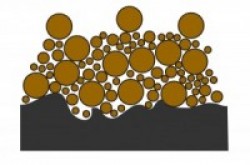As described in a preceding blog, changing ultrasonic frequency has a demonstrated effect on the size of particles removed from a contaminated surface depending on frequency. Low frequencies produce large cavitation bubbles which implode with high energy. High energy implosions are able to dislodge relatively large particles from a surface. Higher frequencies produce smaller cavitation bubbles which, although they implode releasing less energy, are able to remove smaller particles as they are able to penetrate the “barrier layer” found near the surface being cleaned. This knowledge and the relationship of particle size vs. the ultrasonic frequency can be very useful when contaminants consist of consistently sized particles. In the real world, however, a particle population is likely to consist of particles of varying sizes in which case the frequency/particle size relationship becomes a bit more complex.
Being aware of the benefits of using multiple frequencies for cleaning, many users employ ultrasonic equipment which is capable of delivering ultrasonic energy at a number of discreet frequencies. The general notion is that one first subjects a part to cleaning at one frequency and then at another to derive the benefits of multiple frequencies. A model can be put forth, however, that tells us that a better way would be to sequence repeatedly through a number of frequencies. Let me explain – –
First, we must assume that the contaminant involved consists of a collection of particles of varying size distributed on a surface. Further, let us assume that the particles have a natural attraction to both the substrate (surface being cleaned) and to each other. The illustration below shows such a situation.

The effect of first applying a lower frequency will be to dislodge and remove the largest particles on the surface as well as some of the smaller particles near the surface. The remainder of the smaller particles on the surface are not affected as a result of the barrier layer which is created by the remaining larger particles below as shown in this illustration.

Applying a higher frequency will remove some of the smaller particles remaining on the surface. However, due to their lack of intensity, the larger particles will remain as shown below.

The exposed layer of larger particles is removed by a subsequent application of lower frequency ultrasonic energy. However, smaller particles thus exposed are not removed due to the barrier layer effect.

Remaining small particles are removed by a subsequent application of high frequency ultrasonic energy.

The message of the above is that simply applying one, two, or more ultrasonic frequencies in succession may (likely) not produce the required cleaning effect in many situations especially if the particle population is made up of particles of differing size. Repeated sequential application of frequencies may produce a better cleaning result. The appropriate “recipe” of frequencies and exposure times can be developed by conducting cleaning trials and comparing the results using various combinations of frequencies.
– FJF –



 English
English Spanish
Spanish Chinese
Chinese Canada
Canada Mexico
Mexico United Kingdom
United Kingdom



